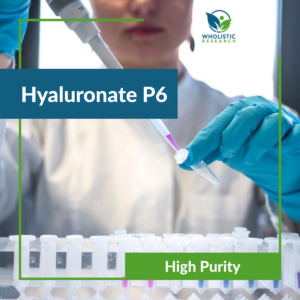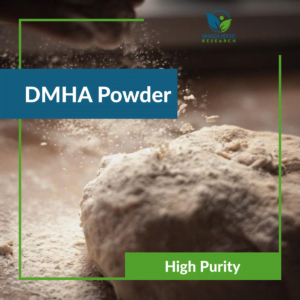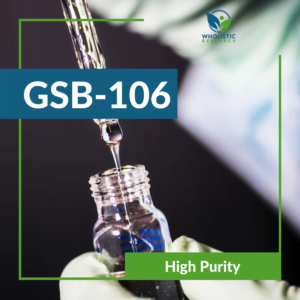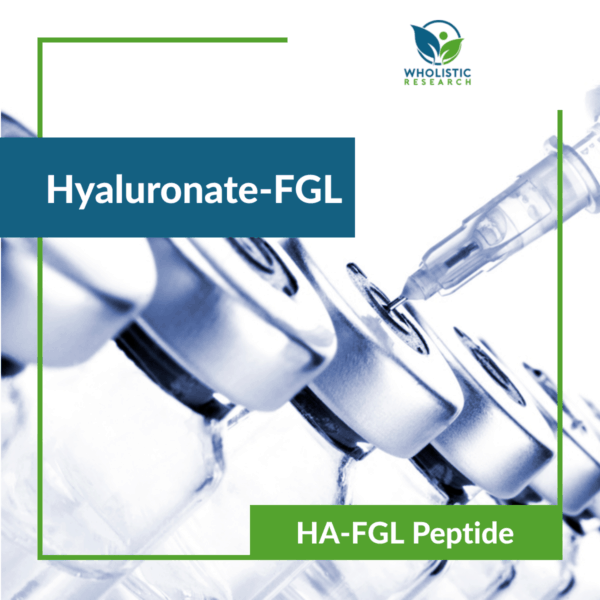
HA-FGL
- Hyaluronate FGL Peptide
- FREE Worldwide Shipping
- Made in UK Labs
- 100% Secure Checkout
- Quality Guaranteed (Money-Back)
Description
HA-FGL IS NOT FOR HUMAN CONSUMPTION
HYALURONATE IS MADE INFUNCTIONAL, MEANING ZERO CD44 INTERACTION
DMSO IS NEEDED FOR SOLUTION
What Is HA-FGL?
HA-FGL can be most briefly described as a polysaccharide covalently bound to a peptide. The polysaccharide is hyaluronate. Hyaluronate is a ubiquitous, endogenously present carbohydrate that is used much like scaffolding in the body. It controls inflammation and extracellular remodeling, and growth.
FGL is a sequence of amino acids bound together that copies the sequence of amino acids found in the powerful growth factor called NCAM, which stands for Neural cell adhesion molecule. By copying the amino acid sequence, it can replicate any relationship with receptors that it may interact with.
NCAM and polysialylatic acid bind together to control the sticking together of neurons, and can great neurogenesis in far-reaching brain regions through sticking neurons together to make a chain that can transport neural precursor cells [R].
It uses a hyaluronate size about twice the size of Injuv’s hyaluronate. It’s 10Kda in size and has 35% of its active regions (that bind with CD44) replaced with amide joiners to attach FGL. This does mean it loses some of the sites that are used to be absorbed.
How Does HA-FGL Compare to Other Nootropic Peptides?
It’s one of a kind. It’s a strong glutamatergic that also grows dopamine neurons, and alters factors related to dopamine function, such GSK-3B phosphorylation, whilst being anti-inflammatory and gliogenic (oligodendrocytes, not microglia which contribute to inflammation.
This is more of a restorative peptide than an outright nootropic. It seems to interact effectively with early exposure PCP (Phencyclidine) [R], TBI [R], and potentially reverse the damage of cannabis [R].
How Does HA-FGL Work?
HA-FGL explained:
PKC
PKC is “Protein Kinase C”. Kinase just means that it can add phosphorus atoms onto other proteins. Phosphorus “activates” or “deactivates” them in a certain way, and there can be many Phosphorus sites on a protein. Protein kinases have a wide family of different forms, and in the case of Protein Kinase C, they can do opposing actions. So, if you look on google scholar and find some worrisome action of PKC, it could be because it’s a certain form. PKC delta is responsible for cannabis induced memory loss [R], and reduces insulin signaling [R]. However, it has been shown that FGL activates PKC alpha, beta, or gamma [R], and that these different isoforms have almost equal GSK3B phosphorylation [R].
AMPA
Via binding to FGFR1 and FGFR2 [R] it stimulates the activity of Protein Kinase C, which stimulates the activity of AMPA receptors via dragging them to the “front line” of neuronal activity, the plasma membrane, on a long term basis. This is big news for people who enjoy Aniracetam, Sunifiram, Unifiram, and even Piracetam and Oxiracetam. In fact, every single one of those compounds is part of the Piracetam family, and they all are known to partly work through AMPA receptors. Oxiracetam and Aniracetam especially.
Ginseng [R], and BDNF [R] compounds are also regulators of AMPA receptors. AMPA is a big name in nootropics, and that could be because they are the most abundant form of excitatory receptors in the nervous system. They’re huge dictators in whether neurons fire or don’t. More firing, more network activity (and inhibition as GABA cells express AMPA too), means more NMDA activity means more learning and “intelligent processes”.
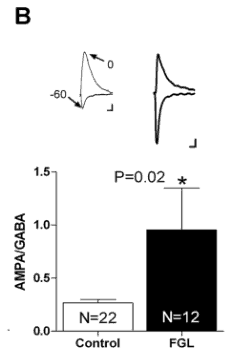
Here we can see an increase in AMPA currents, when controlling GABA [R]
However, there are many ways to alter AMPA receptors, and FGL is very rare because it can stimulate PKC for 24hours after treatment, and make PKC actively bring new AMPA receptors to the surface of neurons, as some PKC activity doesn’t (there are many families of PKC). Aniracetam for example, is thought to work by preventing AMPA receptors from down regulating [R], and cholinergic release.
How much does FGL raise AMPA?
Receptors make neurons have a current of electricity, and that’s why they measure currents from agonists of AMPA. Our unit in which case, is electricity. Below we can see that FGL increases AMPA currents by two fold.
How long does FGL raise AMPA currents for?
For at least 24hours after clearance.
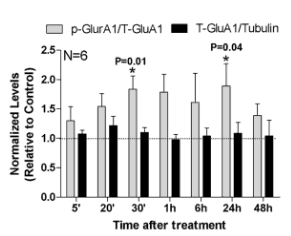
There is conflicting data on the synaptogenic effects of FGL. It certainly improves synaptic connections, but in a way that could be described as “maturing” them. This is both good and bad, like all forms of plasticity.
GSK-3B
Inhibiting GSK-3B is a commonly thought mechanism of Lithium in benefiting mood disorders. It has wide reaching benefits. [R]. It is overactive in long term cannabis use [R], and PKC alpha-
IGF-1
FGL normalizes IGF-1 levels in old aged rats, without altering levels in younger rats. IGF-1 is a potent and holistic anti-inflammatory, and contributes to the potential of it being used to combat neurodegenerative inflammation related diseases and illnesses, including depression [R].
CD200
CD200 is an anti-inflammatory, which is released by FGL [R]
Oligodendrocytes
Oligodendrocytes do the house cleaning in the brain. They are active during sleep. FGL has a specific proclivity to turn stem cells into oligodendrocytes, which is really good! [R]
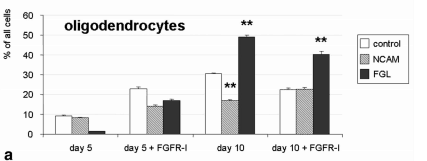
Increase stem cell proliferation number

Roughly, an extra third of proliferating cells in adult rats. [R]
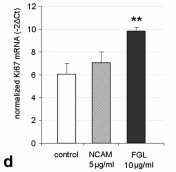
Erk activation
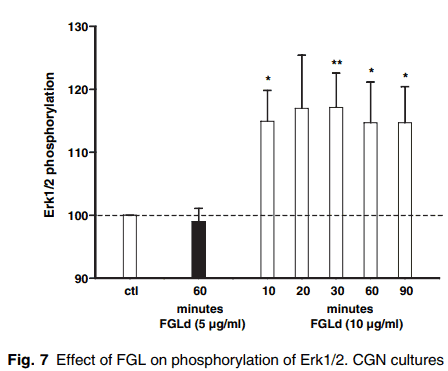
Here we can see the increases that FGL (the black bar is with FGFR’s inhibited) brings to Erk activation/phosphorylation. A sustained 15% is still significant, which is evidenced by the extended neurites. This is how it grows dopaminergic neurons. [R]
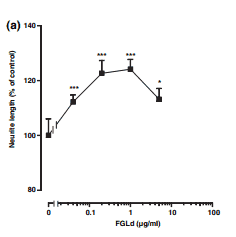
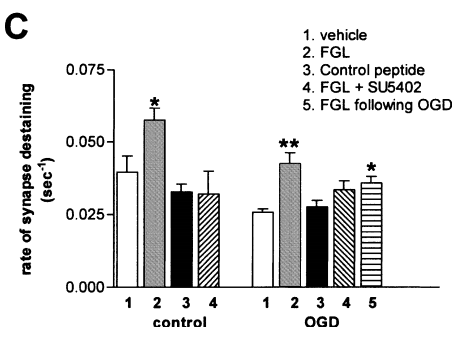
FGL enhanced the number of synapses in the hippocampus [R]
Unparalleled Absorption
This section is important to understand.
FGL is normally only absorbed via receptor-mediated endocytosis, via FGFR1 and FGFR2. That’s right folks, drugs can go into cells and pass barriers through the receptors they agonize. HA-FGL can use three receptors; The additional hyaluronate receptor, CD44. Hyaluronate also allows for extracellular trafficking, and transportation via the trigeminal nerve…
“the signal observed in the entire brain at 6 h might be attributed to the conjugate delivered through the trigeminal nerve-mediated pathway, enabling the delivery of drugs to the hindbrain.”
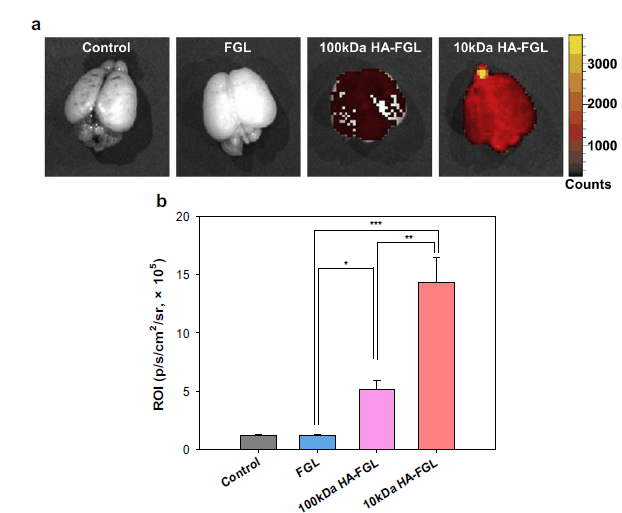
It takes six hours to get everywhere, but it really does seem to get everywhere. Remember that you are not just seeing the cortex (the outer folds of the brain), as radiation (the technique used to display where the peptide goes) travels through the brain to hit the detector, meaning that it has likely also gone deep in the brain.
HA-FGL Dosage & Side-Effects
Side effects are very possible with this compound. Young healthy rats experience widespread apoptosis, despite memory improvements.
Side effects of the FGL peptide do exist. In young rats on high doses (around 100mg Human equivalent dose) every other day for two weeks, huge brain loss was found, despite improving memory. The dosage was high, higher than other studies, and personally is a bizarre dosage to choose. This widespread apoptosis was completely blocked when administered with Amyloid plaques, a well-known cause and consequence of the Alzheimer’s pathology. It seems that these plaques interfere with apoptosis.
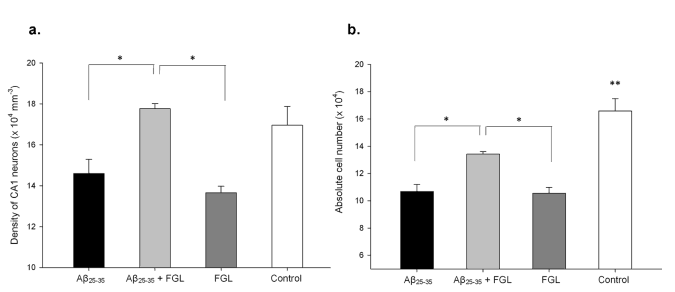
Why did this happen?
The scientists theorized that because FGL inactivates GSK3B, that extrinsic apoptosis became sensitized, causing apoptosis to happen in every hippocampal region tested! Intrinsic apoptosis occurs when GSK is too active, meaning there is clearly a balance that must be achieved. This was concluded because very similar results have been seen with a synthetic GSK inhibitor. However there were more inhibited GSK proteins in the amyloid injected group, than in the FGL alone group. What this means is that the amyloid plaques stop excessive GSK inhibition from being apoptotic, rather than preventing GSK from being inhibited at all. Amyloid plaques also have a buffering effect against calcium, so its difficult to pin point how the amyloid prevents apoptosis, as it could be GSK or calcium.
GSK inhibition does not have much research to indicate it can backfire, and cause apoptosis, because GSK is too high in so many disorders, and even lifestyle models in rodents, such as a high fat diet, meaning there has been a bias to study the pathologically relevant GSK level (when it’s too high), which is the opposite of the actions of FGL. Nonetheless, more on the actions of inactivation of GSK causing apoptosis can be read here, and here, and especially here.
Remember that inhibiting GSK can have many benefits to dopamine, axonal guidance and cell proliferation, and AMPA activity. FGL is very strong, and it overshoots when the dose is high.
Calcium
Calcium is a necessary evil that does good, when in the right amounts. It seems necessary to form long lasting memories in mice [R]
Calcium is toxic to cells, yet is a primary regulator of every learning and cognitive process you’ve wished for more of. The actions of FGL depend greatly on NMDA activation and calcium influx. This should mean that it is not likely to give seizures (in healthy individuals) because it depends on normal activity happening, thereby not allowing uncontrolled, exponential which is an agreeable statement however there are still other concerns. This quote supports this concept:
“If the peptide indiscriminately increased synaptic transmission, it might overexcite neurons and lead to epilepsy, he said. But by heightening synaptic plasticity only in response to activity, the peptide helps the animal encode information more easily, leading to better memory.”
Taking HA-FGL with other compounds could very possibly cause too much calcium to enter cells and trigger apoptosis! Taurine is an effective option for reducing calcium toxicity [R].
Anxiety from too much calcium and AMPA activity is something to be careful of.
PKC and working memory
Overactive PKC in the prefrontal cortex can cause working memory impairments, however few studies keep PKC activation to be dependent on NMDA activity, meaning the spatial encoding of neuronal firing is lost in studies that stimulate PKC without restriction, unlike FGL. PKC inhibition can improve working memory in older rats [R], and PKC activity is linked to stress. FGFR1 induced PKC activity doesn’t seem to display working memory impairments, as I can’t find any evidence of it, and FGL given rats even when young do not display any cognitive impairments (see below) [R].
PKC activity is related to stress responses, not the good kind of stress either [R]. Interestingly, it was related to working memory impairments in an elderly population [R] however this doesn’t concern me, as the PKC form wasn’t specified, and would happen through entirely different mechanisms to FGFR1 activation.
Contraindications
Several conditions and diseases would be detrimental if co-existing with FGL presence.
Bipolar, Anxiety disorder, any form of epilepsy, alcohol dependence or preexisting addiction, benzodiazepine dependence or any previous addiction to Benzodiazepines. Schizophrenia is a widely varied disorder, where some may benefit, and others may really not benefit at all.
AMPAkines are part of the progress toward making new Schizophrenia treatments, however such strong AMPAkines like HA-FGL are in a different, and untested class of nootropic treatment.
Frequently Asked Questions (FAQ)
Your questions answered.
What is the HA-FGL Peptide Used for?
Traumatic brain injury, Stroke, glucose and/or oxygen deprivation. The FGL (L) and even FGL (S) peptide is being used for Alzheimer’s. Fun fact: FGLs was hidden in the first research paper discovering its efficacy!
How Often Can I Use HA-FGL?
Unknown, but it can’t be used twice in 6 hours, as it takes at least 6 hours to be fully absorbed. It has a half-life of between 2 and 3 days, and the activity can persist for an extra 24hours and the memories formed during FGL activity persist for several days afterwards, in rats.
Where to Buy HA-FGL?
Whatever you do, don’t try to buy normal FGL. The 15 amino acid sequence DOES NOT WORK! It must be dimerized in some form, on the correct terminal, with a suitable distance between each monomer. The most verified way is using imino-diacetic acid, but it is VERY expensive! Hyaluronate manages to achieve all of these things.
How is HA-FGL different from FGL?
The hyaluronate molecule attached to the FGL peptide, makes it absorbed much further, and through more mechanisms of absorption than FGL peptides, even in its different forms. Hyaluronate also sustains the activity of the FGL peptide from 5 hours to 2-3 days, by blocking enzyme sites that usually digests the peptide to be inactive. This makes the dosage remarkably low. The greater absorption across the entire brain can lead to cognitive effects that even nootropic experts are not familiar with. Nootropics rarely can read the hindbrain, forebrain, and midbrain. HA-FGL is better absorbed intranasally, than intravenously.
Summary
FGL is a gliogenic, neural differentiating, possibly synaptogenic, anti-inflammatory synaptically strengthening cognitive stimulant which has many different forms. It can have side effects if used improperly. Amyloid plaque related damage, GSK3B over activity, (caused via many dopaminergic drugs) may buffer against FGL’s negative effects. The hyaluronate modifications make FGL astoundingly more potent, due to drastically better absorption and half-life.
Additional information
|


